AN EXAMINATION OF THE PATINA AND CORROSION MORPHOLOGY OF SOME ROMAN BRONZES
DAVID A. SCOTT
2 THE OBJECTS AND THEIR CORROSION
2.1 STRUCTURE
The J. Paul Getty Museum houses a small but important collection of classical bronzes, mostly Greek and Roman. Within this collection are three bronzes of Roman origin but otherwise of unknown provenance: Togati, Roma, and Venus (Demeter)(figs. 1–6). These bronzes were reputed to have traveled through the art market from the same source. A fourth bronze, a winged Nike or Victory (Cleveland Museum of Art), was also reputed to have been obtained through the art market from the same source.
Fig. 1.
Bronze Togati, reflief with two togate magistrates (Togati), A.D. 40–68. 26 cm high. J. Paul Getty Museum (85.AB.109)
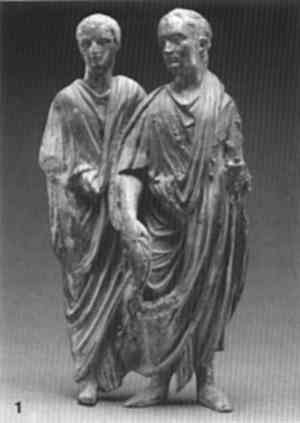 |
Fig. 2.
Togati reverse showign open casting of the back, preserved corrosion products, and, toward the right border, surface modeling originally in the wax
 |
Fig. 3.
Bronze Roma, A.D. 40–68. 33.1 cm high. J. Paul Getty Museum (84.A.B.671)
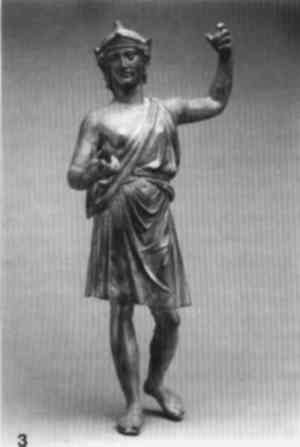 |
Fig. 4.
Roma reverse showing rectangular hole and surface detail
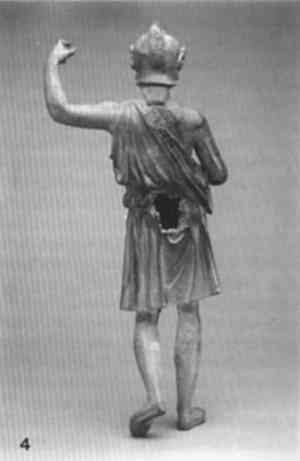 |
Fig. 5.
Bronze Venus (Demeter), A.D. 40–68. 32 cm high. J. Paul Getty Museum (84.AB.670)
 |
Fig. 6.
Venus (Demeter) reverse showing rectangular hole and corrosion
 |
The Togati, also known as Relief with Two Togate Magistrates(figs. 1, 2), shows two figures dressed for a patrician ceremony. These bronzes may originally have belonged to a frieze; there is a break along the older man's left side which suggests that the figures could possibly have been continued. Details of dress and clothing suggest many comparisons, as does the hair on the older figure, brushed forward on the neck, as in contemporary portraits of Caligula, Nero, and their contemporaries (Herrmann 1988). The two figures were cast in one piece, with heads downward, as evidenced by being more porous toward the feet (Podany 1988). There is evidence of a riser or vent on the right hand of the proper left figure. The right arm and toga sleeve of the left figure have been cast on, and this area has corroded somewhat differently and is separated in places from the main body by as much as 3 or 4 mm. The pupils of the eyes are drilled and the backs of the figures are left open. The thickness of the bronze varies from 17 mm in the body of the older man to 5 mm in the head of the younger. There are four diamond-shaped marks on the back surface, almost in the center—marks made in the wax, perhaps for registration (Podany 1988).
The Roma(figs. 3, 4), which may originally have been a chariot attachment, is shown wearing a short tunic unfastened on the right shoulder and an Attic helmet with a visor and crest. Roma was shown standing in this dress on coinage from the time of Galba onward, dating to A.D. 69 (Herrmann 1988). The torso, head, left arm, and a small part of the left leg of the Roma were hollow cast in one piece by the direct lost-wax process. The right arm probably was attached by casting on, as were the legs and feet. A flow of metal is visible on the inner surface, showing that the piece was upside down when this casting-on process was done. The large rectangular hole in the back may have been used to remove casting core material and possibly to mount the bronze. The thickness varies from 4 to 8 mm. Filling material, probably lead, has been poured in, giving the Roma substantial mass. An unusual feature of the surface of the Roma is the appearance of a hexagonal pattern, preserved pseudomorphically in the corrosion crust.
The Venus(figs. 5, 6) is clad in a long tunic unbuttoned down the left. Over this tunic is wrapped a palla. Venus wears a diadem, and in her left hand she offers a libation from a patera. The details suggest imitation of the high classical Attic style of 430–410 B.C. (Herrmann 1988). Although the dress of the Venus was popular in coinage of the period from A.D. 120–150, the Venus is probably earlier. Herrmann (1988) states that it probably was found with the bronze relief of the Togati, which can be dated confidently to the middle of the first century A.D. Although larger in scale and in higher relief than the Togati, the Venus statuette could have come from a separate composition, but the detail of the drapery is so similar that it appears likely that they were produced in the same workshop. The Venus is hollow, and was direct cast with the head and body integral. Numerous chaplet repairs can be seen, and part of the surface shows the same hexagonal network structure in the patina as the Roma reveals. Voluminous corrosion on the back suggests that the burial environment allowed sufficient space for localized corrosion to develop and for the copper carbonates to be retained on the surface in botryoidal or mammilar form.
The Nike, or Victory, in the collection of the Cleveland Museum of Art (fig. 7) is thought to have come from the same locality as the three Getty pieces. Christman (1988) notes that the left arm, right leg, and wings were cast separately from the body, which is hollow, a very similar mode of manufacture to the Venus and Roma. In an ancient restoration the wings were repositioned, further apart from each other and lower.
Fig. 7.
Bronze Nike, late 1st to early 2d century. 42 cm high. Cleveland Museum of Art, Leonard C. Hanna, Jr., Bequest
 |
All four objects are assigned a date between A.D. 40 and 68, and all are made in leaded tin bronze by the lost-wax process with cast-on additions. Further details of their x-radiography and casting were reported by Scott and Podany (1991).
2.2 CORROSION AND PATINATION
Low-power binocular microscopy (10–50x) was used to examine the bronzes, which preserve a number of different corrosion products. These products were characterized by Debye-Scherrer powder x-ray diffraction (XRD) and have been previously reported (Scott and Podany 1991). On the Venus, for example, blue crystals were identified as azurite; off-white as a mixture of quartz, calcite, and cuprite; black as romarchite and cassiterite; green as cassiterite; and gray as cuprite and quartz. Analysis of samples from the Togati identified pale blue as azurite; light green as malachite; and a second sample of light green as cassiterite and malachite. The corrosion products on both bronzes are tin oxides and basic copper carbonates. There is nothing unusual about the identity of these corrosion products: what is remarkable is the variety of corrosion morphology observed on each of these objects. Some of the features discussed here are illustrated in figures 8–13.
Fig. 8.
Fibrous malachite crystals growing from surface on the uncleaned back of the Togati. 30x
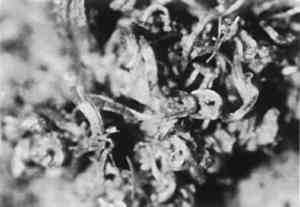 |
Fig. 9.
Photomicrograph under crossed polars of fibrous malachite crystal fragments removed from the crystals on the Togati shown in figure 8. Each curled malachite fiber is comprised of a bundle of fine individual fibrous crystals, which under a quarter-wave plate show different orientations. Mounted in meltmount, refractive index 1.659. 45x
 |
Fig. 10.
Cleaned patina on the lower front of the figures of the Togati, illustrating surface mottling. The patina is principally composed of tin oxide with darker regions of higher iron content. 11x.
 |
Fig. 11.
(above). Partially cleaned patina close to folds of the clothing in upper right of the Togati. Dark green corrosion products cleave easily from the smooth patina. Some pseudomorphic preservation of structure is still apparent in the green stratum, suggesting interdendritic space of a dendritic structural origin. 13x
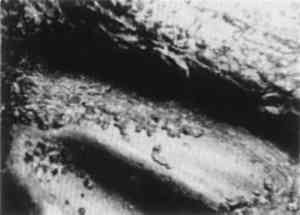 |
Fig. 12.
(left). Tin oxide–rich patina with isolated pustules of corrosion products. partially cleaned surface of front of the Togati. 8x
 |
Fig. 13.
Tin oxide–rich patina with view of surface below a pustule on the front of the Togati showing cuprite zone immediately below the pustule. 10x
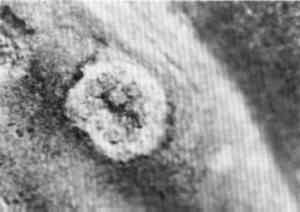 |
Figure 8 shows a surface view at low magnification of fibrous malachite growing on the reverse of the Togati. Malachite, Cu(OH)2. CuCO3, is unusual because it can be found in many different crystalline forms. In most ancient copper alloys, malachite can occur as fragments that have a subconchoidal to massive fracture (Palache et al. 1951; Gettens and FitzHugh 1974). Individual fragments may be acicular, short, or long prismatic crystals with wedge-shaped terminations, sometimes twinned. Malachite corrosion crusts are usually compact, sometimes botryoidal, mammillary, fibrous, or silky. Even similar malachite fragments on the same object may have different optical properties. For example, on a Roman mirror in the Getty collection, some crystals were found to have negative elongation with oblique extinction, while others gave a positive elongation with oblique extinction. The subtlety of crystalline variations in malachite formed on ancient bronzes, or indeed in mineral specimens, has not received any attention that the author is aware of. Each malachite fiber on the Togati is made up of an aggregate of fiber bundles, as shown under crossed polars (fig. 9). Under the quarter-wave plate, these composite bundles give a variety of colors arising from the different orientation of the individual crystals. Fibrous malachite is not common as a corrosion product on ancient bronzes and has rarely been reported (Fabrizi and Scott 1987; Chase 1993), but it is probably seen more often by conservators than the literature would suggest.
In areas where the surface has been cleaned, the Togati has a smooth, sometimes mottled patina (fig. 10). Not only does this patina preserve pseudomorphic remnants of dendritic structure, but it also has a mottled color ranging from pale brown to umber and a smooth, matte appearance. Overlying this layer are disseminated fragments of a copper-rich phase whose globular shapes are oriented in a pattern suggesting interdendritic regions (fig. 11). These globular particles can easily be cleaved from the patina using a gentle scalpel movement parallel to the patinated surface. Figure 12 illustrates the occasional interruption to this smooth patina on the front surface by warty corrosion. These pustules have an apparently layered structure, judging from the stepwise appearance of the contours visible in figure 12. Beneath each pustule, at the base, the smooth patina is interrupted by a zone of cuprite, evident in figure 13.
A detail of the reverse surface of the Roma near a large opening in the back (fig. 14) reveals an unusual hexagonal network. Each hexagon is about 1 mm across and can clearly be seen in many areas of this surface. This hexagonal network structure is rarely seen in corrosion layers, and it is difficult to explain its mode of occurrence.
Fig. 14.
Reverse of the Roma showing hexagonal network structure preserved in the patina. The boundaries surrounding each hexagon are depressed relative to the patina. 5x
 |
The patina of the Roma is enriched in tin (as tin oxides), compared with the composition of the metal, and has a similar matte lustre with surface mottling in the patina as seen in the Togati. Tin-enriched patinas have been discussed frequently: a good general account is given by Gettens (1969).
Dendritic pseudomorphosis on the surface of the Venus is clearly seen in figure 15, and a complex association of crystalline corrosion products, including fibrous malachite and small cuprite octahedra, is illustrated in figure 16. In other areas of the surface, the malachite is curved and banded in the same fibrous growth formation but has assumed a botryoidal appearance (fig. 17).
Fig. 15.
Cleaned patina on the Venus showing pseudomorphic preservation of dendritic structure in a tin–rich surface on the lower front. 8x
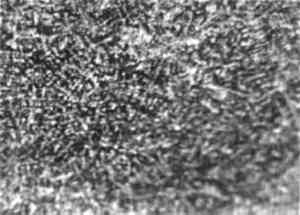 |
Fig. 16.
Reverse of the Venus (Demeter) showing complex array of minerals, mostly cuprite, melachite, and azurite. Fibrous malachite crystals are present, as are occasional cuprite octahedra. 8x
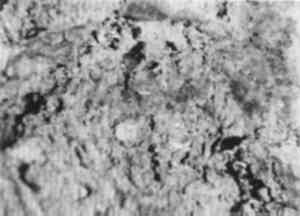 |
Fig. 17.
Reverse of the Venus showing uncleaned surface deposits of malachite, some almost botryoidal. The malachite crystals are also curved and fibrous. 11x
 |
The Cleveland Nike also has areas on the reverse preserving fibrous malachite crystals, azurite, and the same patina as that shown by the Togati. A photomicrograph of a dispersion of malachite fibers from the Nike(fig. 18) displays exactly the same features seen on the Togati(fig. 9).
Fig. 18.
Photomicrograph (under crossed polars, with a quarter-wave plate) of fibrous malachite crystals from reverse of the Nike (Cleveland Museum of Art). Mounted in Meltmount, refractive index 1.659. The same crystalline bundles are found on the Togati shown in figure 9. 40x
 |
One other very significant remnant of associated material links these four bronzes: small fragments of red brick or tile are preserved on the back surfaces of the Roma, Venus, and Togati, and the Cleveland Nike had such fragments, too, before they were mechanically cleaned (Christman 1992). Microsamples of these brick or tile fragments were mounted and polished for technical examination and analysis.
|

















